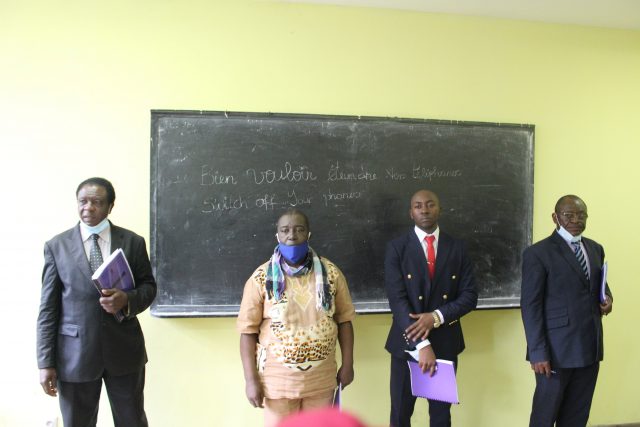This study by Derrick Fofié is based on an analysis of data collected in the field and on results obtained in the laboratory. The research ends with a series of recommendations addressed to populations and public authorities.

Derrick Fofie taking notes from the jury
This work entitle “Study of the dynamics of malaria transmission in Elende, central Cameroon” was carried out by Derrick Fofié as part of his Master’s dissertation in animal biology and physiology at the University of Yaoundé I, in Cameroon. He first started by claiming that “Prior to this study, no entomological surveillance survey had been carried out in Elende; a locality in central Cameroon”. The aim of his study was to determine the abundance and composition of the major malaria vectors present in the area as well as study their behavior and disease transmission pattern. For several months, the young researcher measured the degree of sensitivity of vectors vis-à-vis the insecticides recommended in public health. He assessed the role of insecticide resistance on the transmission of malaria. His survey is a pioneering work. The main objective of this study was to provide basic data related to the dynamics of malaria transmission in the town of Elende. The results revealed that, there is a high density of anopheles in Elende. According to him, the area of study is dominated by the species Anopheles funestus. Derrick Fofié noted that, within the spatial framework of the study, this species plays a leading role in the transmission of malaria with a sporozoite index and very high entomological inoculation rates during the rainy season. In addition, the populations of Anopheles gambiae show a high level of resistance to almost all the insecticides that have been tested at Elende, with the exception of Pirimiphos-methyl for which total sensitivity has been observed. Efficacy tests of commercialized mosquito nets carried out on these same populations indicated a reduced performance of standard mosquito nets but with better efficacy of second generation mosquito nets which have the particularity of containing Piperonyl Butoxide (PBO).

Scientific community receiving the candidate’s study
The detection of the L1014F-kdr mutation at high frequencies revealed by this study shows that this mechanism is potentially involved in the decrease in the performance of mosquito nets on resistant Elende mosquitoes. On the other hand, even if the insecticidal effect of mosquito nets is greatly impaired due to resistance, their physical property is independent and remains a barrier limiting mosquito bites during sleep. This reduces the risk of disease transmission. The detection of the L119F-GSTe2 mutation shows its involvement in the transmission of malaria, where only mosquitoes carrying the resistant allele for this GSTe2_L119F marker were the most infected and therefore would be the most involved in the transmission of malaria in the locality. At the end of this study, Derrick Fofié recommends the widespread and regular use of mosquito nets. As far as, these have been proven to limit the transmission of malaria. He supports the idea of intensifying sanitation around homes. To the public authorities, he recommends integrating the distribution of second-generation mosquito nets into anti-vector control programs. That is, nets that contain in addition to the insecticide, Piperonyl Butoxide and also to promote Indoor Residual Spraying (IRS) based on Pirimiphos-Methyl. As a junior researcher, he thinks it would be wise to extend this study to other sites and assess the association between possible markers of resistance and the transmission of malaria. A way of suggesting that there is much work to be done.





